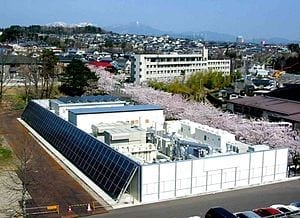
More people in India have access to cellphones than to basic sanitation.
Meanwhile, more than 7,000 villages in the northwestern part of the country suffer drinking water shortages as the water table in this breadbasket region continues to drop. And the same story can be told all over the world, according to participants of a water conference at Columbia University on March 28.
This may be the “Blue Marble” with 70 percent of the planet’s surface covered in watery oceans, but the abundance is primarily made up of saltwater. Freshwater that’s clean enough for people to drink and plentiful enough to grow crops and other vital human activities is in increasingly short supply.
In the U.S., agriculture, industry and people combine to use more water than flows in the nation’s rivers. The difference is pulled up from beneath surface of the earth. “We depend on ground water, it’s going away,” noted economist Jeff Sachs, director of the Earth Institute, which convened the State of the Planet: Water conference. “This is a new geologic era where humanity has taken over key [planetary] drivers: the water cycle, carbon cycle, nitrogen cycle.”
The obvious solution, at least to economists, is: if water has become a scarce good then it needs an appropriate price to properly allocate it. Water engineer John Briscoe of Harvard University noted that Australian farmers survived the recent crippling drought—which resulted in a 70 percent reduction in water flow in the Murray-Darling river basin—because of a water trading system that shifted water use from low-value, high-water use crops like rice to cities that needed the H2O more. “This is Econ 101 at work,” he said.
Financial products innovator Richard Sandor—pioneer of interest rate derivatives and carbon market evangelist—suggested that water would prove the big commodity play of the 21st century. He predicted that both water quantity and quality could be traded as goods. Such a cap-and-trade market also garnered support from Brian Richter, leader of the global freshwater team at The Nature Conservancy: “There is an ability for a market-based system to provide strong incentives to drive water conservation,” he noted. “Efficiency of use goes up very quickly.”
The problem is that “efficiency of use” may mean some get to use no water at all. Many farmers in Australia have been driven bankrupt by the drought, as Briscoe admitted while also arguing that a market proved better at allocation than government rationing would have. “Markets are well-trained to ignore the poorest people,” the Earth Institute’s Sachs later countered. “They direct the resource to those who will pay for it and direct it away from those who cannot.”
As a result privatizing water has not proven popular, prompting protests and even riots. Demonstrations in Bolivia in 2000 and 2005 turned back a similar government scheme and the mayor of Atlanta canceled a private water supply contract in 2003 because the company failed to invest in maintenance.
Privatized water has even led to public health catastrophes around the world. When water was priced out of reach of the poorest South Africans in 1998, they turned to contaminated water in streams, ponds and lakes and thus endured one of the nation’s worst cholera outbreaks between 2000 and 2002.
Government management of water is not without its own problems, however, thanks to everything from a lack of tools to outright corruption and theft. “We are trying to figure out what works and what does not,” said mechanical engineer Vijay Modi of Columbia University, who directs infrastructure programs for the Millennium Villages Project. “We do not have a magical solution.”
One idea is to treat water more like cellphone minutes. Sachs suggested employing “smart cards” that would credit everyone with a basic amount of water—Sandor calculated the amount needed for “hydration and hygiene” at 20 to 30 gallons per day—and then allow the purchase of water above that amount like prepaid minutes on a cellphone. “An affordable or zero price for some basic amount and, if you need more than that, you pay the marginal cost for that water,” Sachs said.
That also might work well for higher volume users, like farmers who rely on irrigation. Agriculture accounts for 70 percent of world water use, much of which is wasted. “It takes water to grow our food and other crops we’re so dependent on,” the Nature Conservancy’s Richter said. “Can we do that while using less water? I’m convinced we can.” Simply shifting from flood irrigation to pivot or, even better, drip irrigation could cut water use by as much as 20 percent in agriculture.
The Latest Bing News on:
Water shortage
- Anger, determination fuel vigil day after 10th anniversary of Flint water crisison April 27, 2024 at 10:00 am
The feelings of anger and pain simmered in the room, but determination in resolving the issues Flint is still facing boiled up to the top.
- Water crisis adds to woes of Khulna residents amid extreme heaton April 27, 2024 at 12:52 am
Crisis of drinking water has turned acute in Khulna city amid the extreme heat, making its residents' lives miserable.The entire country has been reeling under severe to moderate heat wave since the first week of April and the shortage of drinking water has added to sufferings of Khuna city residents.
- Water shortages, traffic aggravate India's Bengaluru as it voteson April 26, 2024 at 6:55 am
Dire water shortages, flooding, gridlocked roads and poor civic facilities have become major issues in Bengaluru city, residents in India's tech hub said as they voted on Friday in a general election that is otherwise focused on jobs,
- 10 years after Flint's lead water crisis began, a lack of urgency stalls 'proper justice'on April 24, 2024 at 5:52 pm
FLINT, Mich. — Ten years ago, smiling politicians posed for cameras while pushing a button, swapping the main tap water source for this majority-Black, impoverished city to the Flint River — the untreated water that started flowing from residents’ taps would become contaminated when it corroded the pipes.
The Latest Google Headlines on:
Water shortage
[google_news title=”” keyword=”water shortage” num_posts=”10″ blurb_length=”0″ show_thumb=”left”] [/vc_column_text]The Latest Bing News on:
Privatizing water
- Awaab's Law: Private renters 'baffled' at their exclusionon April 27, 2024 at 5:28 pm
In recent months, MPs have called for Awaab's Law to apply to the private rented sector where there are more homes in a dangerous condition. The House of Commons' Health and Social Care Committee ...
- Pitman Farms owes $1 million in unpaid water, sewer fees to Fresno County city. Here’s whyon April 27, 2024 at 7:30 am
The ‘Mary’s Chicken’ poultry processors settled with the city in 2020, but it was given five years to pay the bill. They’re also building a hatchery in the city.
- Celebrity Cruises joins the party at private Bahamas island CocoCayon April 26, 2024 at 9:45 am
Celebrity Cruises made its first trip to sister cruise line Royal Caribbean’s private Bahamas island CocoCay this week.
- A water crisis in Mississippi turns into a fight against privatizationon April 26, 2024 at 7:19 am
The saga in Jackson reflects a wider debate playing out in cities across the country. It's not just about water.
- India’s Water and Sanitation 3.0: A Blueprint for Sustainable Developmenton April 25, 2024 at 11:51 am
Amid the ongoing Lok Sabha general elections in India, the Chair in U.S.-India Policy Studies proposes water, sanitation, and hygiene (WASH) priorities for the new government's agenda.
- 10 Years After Crisis, Flint Is Still Fighting for Clean Wateron April 25, 2024 at 6:39 am
A decade after community activists discovered lead in Flint’s pipes, residents are still fighting for clean, affordable water for all.
- Cyclopure Water Test Kits Used in Colorado Pilot Program to Test for PFAS in Private Well Wateron April 25, 2024 at 4:00 am
CHICAGO, April 25, 2024 /PRNewswire/ -- Today, Cyclopure announced the inclusion of its PFAS Water Test Kit in a pilot program being ... "PFAS Testing and Assistance Program" (TAP) to provide private ...
- Water leak racks up tens of thousands of dollars in charges, DeKalb renter has no wateron April 24, 2024 at 6:34 pm
A DeKalb County family is living without running water after a leak on the property they’re renting racked up a huge water bill.
- Where's the money? Investigators track down Flint water claimantson April 24, 2024 at 3:30 pm
Two retired Michigan State Police troopers who are now private investigators are busily tracking down people who filed Flint water crisis settlement claims and need to provide more information.
- The Sinking Arizona Town Where Water and Politics Collideon April 23, 2024 at 7:20 am
Democrats see an opening to win back rural Trump voters fed up with their groundwater being pumped by huge farms.
The Latest Google Headlines on:
Privatizing water
[google_news title=”” keyword=”privatizing water” num_posts=”10″ blurb_length=”0″ show_thumb=”left”]










